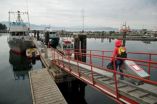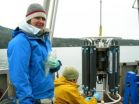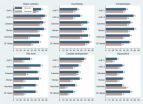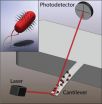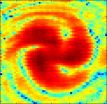(Press-News.org) A complex web of interaction between viruses, bacteria, and their environment is becoming ever more untangled by a growing international collaboration between Matthew Sullivan, associate professor in the University of Arizona's Department of Ecology and Evolutionary Biology and Steven Hallam from the University of British Columbia in Vancouver, Canada.
"Bacteria are drivers of nutrient and energy cycles that power the earth," Sullivan said. "As the climate is changing, so are the environments these bacteria live in, and they in turn loop back to impact their environments. Viruses are also in the mix mediating microbial processes, but how and to what extent? Those are the questions we are trying to answer."
The latest chapter in understanding this complex ecosystem was led by Simon Roux, a post-doctoral research scientist in Sullivan's lab. In a study published in a new, non-profit, open-access journal called eLife, Roux focused on viruses and the microbes they infect in the northeast Pacific Ocean, specifically in vast stretches of open ocean depleted of oxygen, which scientists call oxygen minimum zones or OMZs. The work is unprecedented in its breadth and scope and represents some of the first population-based viral ecology in natural systems.
The take away: Marine viruses appear to be much more important to microbial ecology below sunlit surface waters than researchers previously suspected.
"There are, of course, areas with less oxygen scattered throughout the world's oceans," Sullivan said. "However, the more worrisome OMZs form when oxygen concentrations become limiting to life due to physical processes preventing gas exchange with the atmosphere and microbes respiring to draw down available oxygen."
Sullivan explained that as water columns become increasingly stratified – in other words, no longer mix well – OMZs are expanding and intensifying due to microbial activity that drives chemical transformations resulting in loss of fixed nitrogen that phytoplankton depends on, accumulation of hydrogen sulfide, a chemical toxic to animals and plants, and production of greenhouse gases.
The eLife study focused on a sulfur-oxidizing bacterium called SUP05, which is dominant in OMZs and, like most microbes in the "wild," has not been successfully cultivated in a lab setting. Using cutting-edge genome sequencing technology, the genomes of 127 single cells were generated and then screened using novel computational approaches to look for virus DNA in these single-cell genomes.
"Ultimately we are interested in understanding is how different microbial groups interact to drive carbon, nitrogen and sulfur cycling in oxygen minimum zones," said UBC microbiologist and co-author Steven Hallam. "SUP05 is a hub for metabolic coupling in OMZs. By studying viruses that infect SUP05, we're beginning to recognize that viruses can alter the network properties of microbial communities with resulting feedback on nutrient and energy conversion processes, including the production and consumption of climate active gases."
"The last couple of years have seen a spectacular development of the single-cell genome technique, in which scientists are able to isolate one single cell and sequence all of its genetic material," Roux said. "The resulting datasets allow us to clearly identify and directly link virus to host."
From these 127 single-cell genomes, 69 new SUP05 viruses were identified representing 5 viral groups not yet known to science. These new genomes were then used as references to query 186 available environmental microbial and viral sequence datasets to show that these new viruses were persistent over time and largely did not occur outside the study site. In other words, these viruses and their hosts thrive in oxygen-depleted parts of the ocean where not much else can survive, and they stay there.
Not only did this study reveal the type of viruses that infect these microbes but also features of how these viruses and hosts interact. For one, many SUP05 cells are commonly infected by viruses in nature – about one in three. Second, these SUP05 viruses encode metabolic genes that impact the very functions that these SUP05 bacteria contribute to the OMZ ecosystem – energy and nutrient cycling.
"The finding that viruses could directly manipulate SUP05 sulfur cycling that drives its coupled carbon fixation is critical to developing predictive models about microbial processes in the dark ocean," Sullivan said. "However, it is becoming less and less surprising as we have known for a decade that viruses encode core photosynthesis genes when they infect photosynthetic cyanobacteria."
Roux and Sullivan are affiliated with the newly launched UA Ecosystem Genomics Institute, led by Scott Saleska, associate professor in ecology and evolutionary biology, which seeks to use modern approaches to build an ecosystems-level understanding of microbial communities in nature. Seed funding for EGI was provided by the UA Technology and Research Initiative Fund through the Water, Environmental and Energy Solutions initiative.
"This study represents a solid first step at doing so in an ocean ecosystem focused on OMZs, whose recent expansion we hope to see reversed," Sullivan said.
INFORMATION: END
New research decodes virus-host interactions in ocean dead zones
A new study sheds light on the ecological role played by marine viruses in oxygen-starved regions of the worlds' oceans
2014-09-16
ELSE PRESS RELEASES FROM THIS DATE:
New research shows tornadoes occurring earlier in 'Tornado Alley'
2014-09-16
BOZEMAN, Mont. -- Peak tornado activity in the central and southern Great Plains of the United States is occurring up to two weeks earlier than it did half a century ago, according to a new Montana State University study whose findings could help states in "Tornado Alley" better prepare for these violent storms.
Tornado records from Nebraska, Kansas, Oklahoma, and northern Texas – an area of high tornado activity dubbed "Tornado Alley" -- show that peak tornado activity is starting and ending earlier than it did 60 years ago.
Peak tornado activity, which occurs ...
Long-term results of RTOG 0236 confirm good primary tumor control, positive 5-year survival rates
2014-09-16
San Francisco, September 15, 2014—Patients with inoperable, early-stage lung cancer who receive stereotactic body radiation therapy (SBRT) have a five-year survival rate of 40 percent, according to research presented today at the American Society for Radiation Oncology's (ASTRO's) 56th Annual Meeting. Such a positive survival rate is encouraging considering that historically conventional RT resulted in poor tumor control for patients with inoperable lung cancer. This study is an update of RTOG 0236, originally published in 2010 , and also conducted by the original researchers ...
Politics divide coastal residents' views of environment, UNH research finds
2014-09-16
DURHAM, N.H. – From the salmon-rich waters of Southeast Alaska to the white sand beaches of Florida's Gulf Coast to Downeast Maine's lobster, lumber and tourist towns, coastal residents around the U.S. share a common characteristic: their views about coastal environments divide along political lines. That's a primary finding of a new study by University of New Hampshire sociologists published this month in the journal Society & Natural Resources.
"We found a lot of environment-related differences from place to place to place. Each environment is different so that's just ...
Artworks are people!
2014-09-16
Not all things are created equally. We don't view a Picasso sculpture in the same way we look at a hammer, for example — no matter how fancy the hammer.
The reason? We see the Picasso more as a person than an object, according to new research from the University of Chicago Booth School of Business.
And in some cases, we make distinctions between artworks — say, an exact replica of a piece created by the artist, versus one created by a different artist.
Art, in other words, is an extension of the creator, write Professor Daniel M. Bartels of Chicago Booth, and Professor ...
For electronics beyond silicon, a new contender emerges
2014-09-16
Cambridge, Mass. – September 16, 2014 – Silicon has few serious competitors as the material of choice in the electronics industry. Yet transistors, the switchable valves that control the flow of electrons in a circuit, cannot simply keep shrinking to meet the needs of powerful, compact devices; physical limitations like energy consumption and heat dissipation are too significant.
Now, using a quantum material called a correlated oxide, Harvard researchers have achieved a reversible change in electrical resistance of eight orders of magnitude, a result the researchers ...
NASA's Global Hawk and satellites investigating Hurricane Edouard today
2014-09-16
The unmanned Global Hawk aircraft that's part of NASA's airborne Hurricane and Severe Storm Sentinel, or HS3 mission was winging its way to Hurricane Edouard on September 16. In addition to the Global Hawk, various NASA satellites are continually providing data on the Atlantic hurricane.
Scientific instruments aboard NASA's remotely piloted Global Hawk aircraft have been studying the hurricane over the last couple of days, and the Global Hawk returned to Edouard again today, September 16. Two of the instruments aboard the Global Hawk that will study Edouard are the S-HIS ...
Cancer patients with malignant spinal cord compression have preserved mobility
2014-09-16
San Francisco, September 15, 2014—Mobility is equally preserved in cancer patients suffering from malignant spinal cord compression (MSCC) who receive a single dose of 10 Gy of radiation therapy (RT), compared to patients who receive five daily doses of 4 Gy of RT each, according to research presented today at the American Society for Radiation Oncology's (ASTRO's) 56th Annual Meeting.
Malignant spinal cord compression (MSCC) is a complication of metastatic cancer mostly with bone involvement that occurs when a tumor's secondary deposit presses on the spinal cord and ...
And so they beat on, flagella against the cantilever
2014-09-16
WASHINGTON D.C., September 16, 2014 – A team of researchers at Boston University and Stanford University School of Medicine has developed a new model to study the motion patterns of bacteria in real time and to determine how these motions relate to communication within a bacterial colony.
The researchers chemically attached colonies of Escherichia coli bacteria to a microcantilever – a microscopic beam anchored at one end, similar to a diving board – thus coupling its motion to that of the bacteria. As the cantilever itself isn't doesn't generate any vibrations, or 'noise,' ...
NASA sees Tropical Storm Odile knocking at US Southwest
2014-09-16
Tropical Storm Odile continues to drench western Mexico and has now entered into the U.S. Southwest. On September 15, NASA's Terra satellite saw Odile's northernmost edge crossing the Mexican border into southern California. NOAA's GOES-East satellite on September 16 showed Odile's outer bands were already bringing storms to southern Arizona.
NASA Sees Odile Knocking on U.S. Border
On Sept. 15 at 2:35 p.m. EDT, the Moderate Resolution Imaging Spectroradiometer instrument aboard NASA's Terra satellite saw the northern fringes of Hurricane Odile straddling the border ...
Scientists twist radio beams to send data
2014-09-16
Building on previous research that twisted light to send data at unheard-of speeds, scientists at USC have developed a similar technique with radiowaves, reaching high speeds without some of the hassles that can go with optical systems.
The researchers, led by electrical engineering professor Alan Willner of the USC Viterbi School of Engineering, reached data transmission rates of 32 gigabits per second across 2.5 meters of free space in a basement lab at USC.
For reference, 32 gigabits per second is fast enough to transmit more than 10 hour-and-a-half-long HD movies ...
LAST 30 PRESS RELEASES:
SIMJ announces global collaborative book project in commemoration of its 75th anniversary
Air pollution exposure and birth weight
Obstructive sleep apnea risk and mental health conditions among older adults
How talking slows eye movements behind the wheel
The Ceramic Society of Japan’s Oxoate Ceramics Research Association launches new international book project
Heart-brain connection: international study reveals the role of the vagus nerve in keeping the heart young
Researchers identify Rb1 as a predictive biomarker for a new therapeutic strategy in some breast cancers
Survey reveals ethical gaps slowing AI adoption in pediatric surgery
Stimulant ADHD medications work differently than thought
AI overestimates how smart people are, according to HSE economists
HSE researchers create genome-wide map of quadruplexes
Scientists boost cell "powerhouses" to burn more calories
Automatic label checking: The missing step in making reliable medical AI
Low daily alcohol intake linked to 50% heightened mouth cancer risk in India
American Meteorological Society announces Rick Spinrad as 2026 President-Elect
Biomass-based carbon capture spotlighted in newly released global climate webinar recording
Illuminating invisible nano pollutants: advanced bioimaging tracks the full journey of emerging nanoscale contaminants in living systems
How does age affect recovery from spinal cord injury?
Novel AI tool offers prognosis for patients with head and neck cancer
Fathers’ microplastic exposure tied to their children’s metabolic problems
Research validates laboratory model for studying high-grade serous ovarian cancer
SIR 2026 delivers transformative breakthroughs in minimally invasive medicine to improve patient care
Stem Cell Reports most downloaded papers of 2025 highlight the breadth and impact of stem cell research
Oxford-led study estimates NHS spends around 3% of its primary and secondary care budget on the health impacts of heat and cold in England
A researcher’s long quest leads to a smart composite breakthrough
Urban wild bees act as “microbial sensors” of city health.
New study finds where you live affects recovery after a hip fracture
Forecasting the impact of fully automated vehicle adoption on US road traffic injuries
Alcohol-related hospitalizations from 2016 to 2022
Semaglutide and hospitalizations in patients with obesity and established cardiovascular disease
[Press-News.org] New research decodes virus-host interactions in ocean dead zonesA new study sheds light on the ecological role played by marine viruses in oxygen-starved regions of the worlds' oceans
